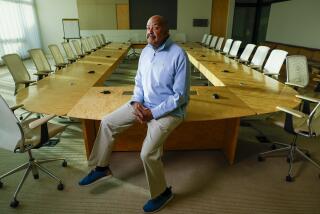For Armenians in the diaspora, that has never happened before.
- Share via
Only Tuesday, the office was in shambles, with chairs piled against a wall, an unopened fax machine in the middle of the floor and a departed tenant’s sign on the door.
Wednesday, somewhat more organized, the office of Los Angeles’s most up-to-the-minute conduit from Armenians in America to those of their homeland has opened.
The suite on the third floor of the office building at 600 W. Broadway opened Wednesday as the permanent headquarters of the United Armenian Fund.
From it, seven major Armenian groups will coordinate flights of medical supplies, food and domestic goods to Soviet Armenia. The relief program began in December and will continue indefinitely.
What makes the office so ahead of its time is nothing so literal as the Merlin phone system and satellite link that will afford it instant communication with Yerevan.
It is rather the presence of the seven major social and charitable groups under one roof, with one set of goals and one plan of execution to benefit the homeland.
For Armenians in the diaspora, that has never happened before.
Theirs is a story of fragmentation--a church that split decades ago into two branches, a political culture splintered on fundamental ideological questions, a national identity shaded by the dozens of host countries through which Armenians have passed.
The Armenian earthquake of December, 1988, brought calls from all sides for Armenians to set aside old divisions.
For the first time in decades, the highest leaders of the branches of the Armenian Apostolic Church met in the United States to urge a unified response to the crisis.
Yet, inertia was strong. Organizations continued to raise their own money and conduct their own relief projects.
It was finally the prodding of a Glendale Armenian journalist that brought the United Armenian Fund into existence.
Harut Sassounian, owner and publisher of the California Courier, is the kind of journalist who works in the gray area between activism and reporting.
In his tabloid newspaper, which carries news of Armenians around the world to about 3,000 subscribers, Sassounian writes a column, speaking bluntly about what Armenians should do and how they should view current events. He also gets involved in causes.
Sassounian felt the existing relief operation was going to be inadequate as winter approached. In November, he called Kirk Kerkorian about it. The real estate investor and airline owner agreed to a simple proposal.
Through his Lincy Foundation, Kerkorian would bankroll relief flights--at a cost of $110,000 to $140,000 each--indefinitely. His condition was that the Armenian organizations work together.
The condition seemed reasonable, considering the past experience of the relief effort, Sassounian said.
“The word comes from Armenia, we need disposable syringes. In the past, every organization, they all wanted to do good. They went around trying to collect disposable syringes. If they needed 100,000, they got 1 million and if they need 10,000 instant formula baby powder milk . . . “
Sassounian thought it a million-to-one shot. He started calling the organizations.
He found the message and the timing were both right. Six more joined, including both branches of the Armenian church and the major charities.
Within a month, United Armenian Fund had incorporated and gathered its first planeload of supplies.
The first flight left Dec.2, with Sassounian on it.
The trip supplied grist for reporting on affairs of the homeland, including a tumultuous debate in the parliament over home rule and the inefficiency of Armenian society under Communist domination.
He also brought back personal reflections on the needs of Armenians:
“In the hills above Spitak, we distributed our truckload of foodstuffs directly to the inhabitants of two villages: Saralar and Ghoursali. . .” he wrote.
“A year later, some are still living in tents under freezing temperatures. The rest live in temporary shacks. They unanimously asked for housing as their first priority. Inside their tents was like a refrigerator. They immediately need heaters and sleeping bags. As we handed the food supplies directly to the families, for the first time since the beginning of our trip we felt good that we were helping our people.”
On that high, Sassounian returned, looking “five years down the road.” He envisions joint ventures, housing projects, factory construction.
But first, one mundane task demanded attention.
In its first two months, the United Armenian Fund had no home of its own.
Its executive director, Michael Mahdesian, set up shop in his parents’ business in Culver City. There he had the bare essentials: phone, fax, copier, computer.
“We wanted direct action, not to talk about it and talk about it,” Sassounian said.
The plan worked. Last Saturday, the fourth and fifth flights of relief supplies left Los Angeles and London at the same time.
And on Wednesday, the United Armenian Fund finally opened its doors.
More to Read
Sign up for Essential California
The most important California stories and recommendations in your inbox every morning.
You may occasionally receive promotional content from the Los Angeles Times.














